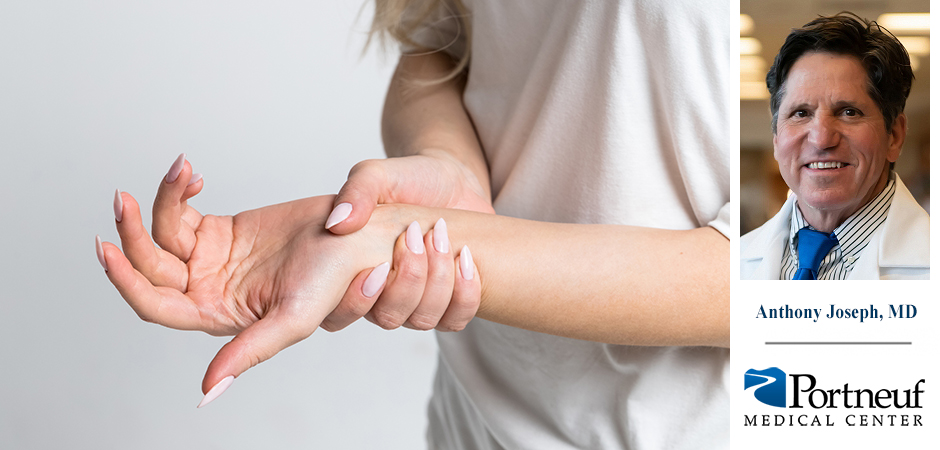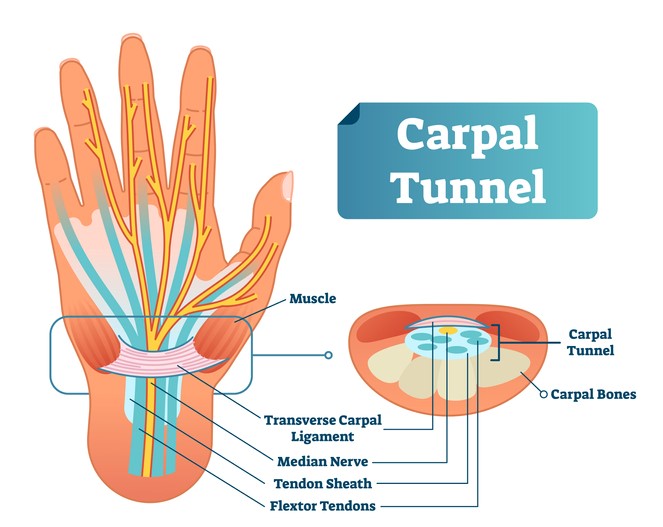
For Nicole Mennear of Pocatello, age 49, decades of repetitive computer work using a keyboard, mouse and a 10-key machine led to pain and tightness in her hands, arms, shoulders and neck muscles.
“I suffered from carpal tunnel symptoms for years,” said Mennear, “but I was afraid of having the surgery, so the pain kept increasing as I continued my work.”
Mennear found a chiropractor who helped her find some pain relief, teaching her good ergonomic practices to help relieve the pain of her repetitive motions. “I even learned to use the mouse with my left hand, which helped for a while, until that hand started to hurt as well,” she said.
Mennear’s primary physician then referred her to Anthony E. Joseph, MD, an orthopedist with OrthoIdaho, who explained the anatomy of the carpal tunnel area and the potential medical issues.
The carpal tunnel is a small area in the wrist, roughly an inch wide. Small bones, called carpal bones, form the floor and sides of the tunnel. The Transverse Carpal Ligament forms the “ceiling” of the tunnel. Located within that space are the median nerve and flexor tendons that help bend the fingers and thumb.
The median nerve begins as a group of nerve roots in the neck to form a single nerve in the arm, through the wrist and to the fingers.
Dr. Joseph diagnosed Mennear with carpal tunnel syndrome – a pinched median nerve caused by excessive hand and wrist activity within the small, confined area of the carpal tunnel.
Dr. Joseph recommended carpal tunnel surgery, but Mennear was not ready for the treatment. Instead, he treated her with shots in her neck where the median nerve originates and referred her to physical therapy. He also injected steroids into her hands, which minimized the pain for nearly two years.
“Even though I wore wrist braces for years, my hands would often be numb and tingle at night,” she said. “I especially enjoy riding my bike, but my hands started to go numb after ten minutes, so I had to stop.”

Finding relief with surgery
Convinced that surgery was her last option to relieve the pain, Mennear conferred with Dr. Joseph and finally made an appointment for surgery. “I was very anxious about the surgery and worried I would have to have the surgeries on two different days,” Mennear recalled. “The physician assistant assured me that it would be possible to have surgery on both wrists on the same day.”
“The surgery center staff were great, explaining how the surgery would work and the recovery period I should expect,” said Mennear. “I was surprised at how quick and easy the surgery was.”
During the surgery, Dr. Joseph numbed the wrist with an injection. He then made a small incision and inserted a device that looked like a hollow knitting needle. Smaller than a pencil, the device has a mechanism inside that slides a blade back and forth. Guided by ultrasound to the transverse carpal ligament, Dr. Joseph flipped a lever that slid the blade out to cut the ligament. This relieves the pressure by giving more space for the nerves and the tendon within the carpal tunnel.
“The surgery for both hands took about half an hour. I sat in recovery for ten minutes and then went home. I felt great and had no problems, but my hands were very numb, and I didn't want to touch anything,” Mennear said.
Recovery from surgery
“During the first day after surgery, my mom was here to help me with everything, but I had very little pain,” Mennear said. “I took ibuprofen for a couple of days and iced my wrists to bring the swelling down. I was surprised at how much I improved each day.”
The team gave Mennear exercises to do after surgery, which helped her get back into her daily life quickly. “I was surprised at how quickly my hands improved. It wasn’t too long before I was able to drive again.”
The only regret Mennear has is the time it took for her to be comfortable with the idea of surgery.
“I put off the surgery for a long time and I wish that I hadn't. I am very happy with the results. My surgery was five months ago, and my hands feel better and stronger than before,” she said.
“I am looking forward to riding my bike without pain when the weather gets better.”
For more information about the hand, wrist and elbow specialists at Portneuf Medical Center, visit our website.